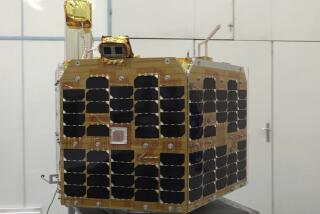Rocket blasts off from Vandenberg, lifts military satellite into orbit
An 18-story rocket carrying a $518-million military weather satellite was launched into orbit from Vandenberg Air Force Base on Thursday, extending the life of a program that began in the early 1960s.
The 7:46 a.m. PDT blastoff was the first of the year for the team at Vandenberg’s 30th Space Wing.
“I couldn’t be more proud of this team of professionals,” said Col. Keith Balts, wing commander. “The team ... worked diligently to ensure that this launch was safe and successful.”
The 2,720-pound satellite will allow military officers to detect developing storms and alert communities of weather-related dangers headed their way.
The spacecraft was developed to scan an area 1,800 miles wide and cover the Earth in about 12 hours, the Air Force said. It is to circle the Earth at an altitude of about 500 miles in a near-polar orbit, continuously sending down imagery for worldwide forecasts.
It is the latest satellite launched in support of the military’s long-running Defense Meteorological Satellite Program, a system initiated in 1962.
“The launch of DMSP-19 continues the vital weather support to operational commanders for another decade,” said Col. Scott Larrimore, director of the space and missile systems center’s defense weather systems directorate. “Congratulations to a great team.”
The Atlas V rocket carrying the satellite was built by United Launch Alliance, a joint operation run by Boeing Co. and Lockheed Martin Corp.
The satellite, built by Lockheed and Northrop Grumman Corp., was manufactured in the mid-1990s. For more than 15 years, it sat in a clean room at Lockheed’s facility in Sunnyvale, waiting for the day it would be launched into orbit from Vandenberg.
The satellites are designed to help identify and determine the intensity of thunderstorms, hurricanes and typhoons for the U.S. military worldwide. The system also provides extensive weather data to the public through the National Oceanic and Atmospheric Administration.
Vandenberg, on California’s Central Coast between Lompoc and Santa Maria, has been the site of military space projects for more than half a century.
The base covers 98,000 acres along the Pacific and has been the primary site for launching spy satellites since the beginning of the Cold War. It has an ideal location for putting satellites into a north-to-south orbit.
In the early 1960s, the Defense Meteorological Satellite Program was highly classified because it supported the CIA’s first spy satellites.
At the time, spy satellites would take pictures of the Soviet Union and other countries on 70-millimeter film in a canister. When all the photographs were taken -- all 32,000 feet worth -- the satellite would drop the can above the Pacific, where it would be snatched in midair by military aircraft, or from the sea by ship.
The weather satellites were ideal for intelligence officials, who could make sure there was no cloud cover over a spy satellite’s target and that the photos taken would be the best quality.
In the program’s more than 50-year history, 42 of the weather satellites have been successfully launched. The spacecraft were initially designed to spend just three to five years on orbit, but many have exceeded that lifetime.
One more satellite remains to be launched for the program. It is set to blast off as needed, tentatively scheduled for 2020.
ALSO:
Advances in electronic warfare fly under the public’s radar
Aerojet Rocketdyne to lay off about 150 workers in Canoga Park
Malaysia Airlines Flight 370: Why aren’t drones helping the search?
More to Read
Inside the business of entertainment
The Wide Shot brings you news, analysis and insights on everything from streaming wars to production — and what it all means for the future.
You may occasionally receive promotional content from the Los Angeles Times.











